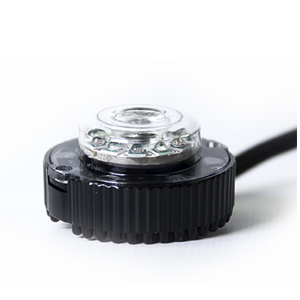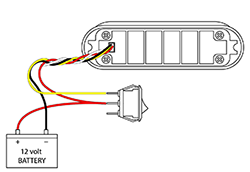LED Strobe Lights Frequently Asked Questions
If you’re curious about strobe lights for vehicles, then you’ve come to the right place. Below, we’ll delve deep into the nitty-gritty of vehicle strobe lights, providing the answers that you need to inform your purchasing decision. Strobe lights don’t need to be complicated, and after reading through this FAQ, you will be clued-up and ready to buy.
What Is A Strobe Light?
A strobe light is a device that produces a particular kind of light. The word comes from the Greek term strobos, which means “act of whirling”.
With non-strobe lights, such as the standard lightbulbs that you have in your home, a continual supply of light is generated. This is not the case with strobe lights; strobe lights produce continual flashes (or whirling) of light. The light produced by a strobe light is usually extremely bright, as more energy can be used for each “flash” of light, rather than needing to maintain a continual beam of light (as with a standard light).
A typical commercial strobe light produces between 10 and 150 joules of energy, which is incredibly powerful and can be seen from great distances. Strobe lights can be used in one of two ways:
- As a flashing light, primarily used to create effects for a concert, or on an emergency vehicle.
- On a “continuous” mode, where the flashes are spaced in such a way that it’s almost impossible for the naked eye to tell they are flashing. This kind of lighting allows a continual beam of bright light to be produced, but is more commonly used in photography than on vehicles.
LED Lights are naturally white, but the beam of light produced can be colored for specific purposes with the application of specialized gels.
When affixed to vehicles, strobe lights are often referred to as “strobe emergency lights” or “strobe warning lights”. The flashes of light can be flashed in a particular sequence, known as a pattern, and many lights have numerous pattern options.
How are strobe lights used on vehicles?
Strobe lights have become a common feature of many types of vehicle. They are used for a number of purposes, but the main usage is usually for awareness. Strobe lighting on a vehicle can help to alert other road users to the presence of the vehicle, which is useful in emergency situations. For example, think of the lights that an ambulance uses to alert other road users of its presence; this will commonly be a strobe light.
School buses also commonly use strobe beacon lights to help counteract issues with problematic driving conditions, such as heavy fog, which a powerful strobe is by far the most effective light to “cut through”. As a result, the bus is more visible to other road users, who then know to take more care in the area due to the presence of a priority vehicle.
Strobe lights are not particularly suitable for lighting the way of a vehicle. If you are looking to enhance the beam of your vehicle’s lights, then standard LED light bars are usually the best choice. Due to the flashing nature of strobe lights, they cannot be relied upon to produce a continuous beam of light that can help to provide extra visibility to the driver. While providing visibility is an important function, it’s visibility for other road users, for awareness purposes, rather than the vehicle with the lights affixed.
What Is A Hideaway Strobe Light?

Hideaway strobe lights are very popular on vehicles, with their “hideaway” feature their primary selling point.
With standard vehicle lights, the lights attached can usually be seen at all times. They are obvious to the onlooker via rigs that are attached to the roof or grille of the vehicle. This is not a problem for many vehicles — such as dedicated emergency vehicles —but can be problematic for volunteer firefighters and medical professionals. After all, it’s usually their personal vehicle that they are affixing the lights to, and they may not necessarily appreciate the loss of aesthetics from heavy lights being permanently installed.
Hideaway strobe lights are a solution to this problem. These strobe lights are hidden from view, as the name suggests. They can be hidden in the existing lights of the vehicle, or mounted onto a surface. As you might expect, hideaway lights are very small— the ANT 6-3 Hideaway LED Strobe Light is just 1.5” in diameter. Despite the small size, this light can produce an astoundingly bright beam of light, but the vehicle it is fitted to looks much as it always did.
Who can use strobe lights on their vehicle?
Technically, anyone can install LED strobes on their vehicle, but whether they can be used is another question. The matter is commonly decided primarily at state or even municipal level, and there are restrictions to the colors that you can use.
Strobe lights are most commonly attached to the vehicles of the following groups:
- Volunteer firefighters and EMTs, especially those living in rural communities where public lighting may be minimal on back roads.
- Construction workers.
- Tow trucks and wrecker vehicles.
- People conducting official governmental work, where extra visibility may be required.
If you wish to use strobe lighting off-road or on private property, there are no restrictions— you can have as many as you see fit, and the colors can be of your own choosing.
What color strobe lights can volunteer firefighters have?
The answer to this question very much depends on your state; the rules for what strobe lights volunteer firefighters have is decided at state, not federal, level.
However, it is safe to conclude that it is extremely unlikely your state will allow you to use red or blue strobe lights on your vehicle. This is simply because these colors are conventionally reserved for professional paramedics, firefighters, or police officers who are operating in a professional vehicle. For obvious reasons, civilians using those colors creates confusion, something that the authorities wish to avoid.
What color strobe light cuts through fog?
As we touched on earlier with the school bus example, strobe lights are excellent at cutting through fog— but is one color better than the rest for this task?
The general consensus is that the longer the wavelength of the light, the better it is able to cut through fog. Red light comes top in this list, with a wavelength of between 620 and 750 nanometers. However, if you are unable to use red light due to state restrictions, orange light is your next best option (590-620 nanometers), and then yellow light (570-590 nanometers).
If buying strobe lights to cut through fog, you should avoid violet (just 380-450 nanometers) and blue light (450-495 nanometers).
What is the brightest hideaway strobe light?
As a general rule, the higher the wattage, the brighter the light it produces. We sell a number of different hideaway strobe lights, but if you’re looking for brightness, we recommend some of the following:
If your looking for a full kit that uses Xenon bulbs...
Or if you would prefer to use LED Bulbs...
When selecting brightness, it’s important to think of the application of these lights. For the most part, strobes are used for awareness. Essentially, if the light is bright enough to be seen in difficult conditions — such as nighttime or during adverse weather conditions — then it’s likely safe to conclude that it’s bright enough. You’re looking to create awareness and increase safety, not dazzle other road users, so keep this in mind when choosing the brightness of your lights.
Who sells strobe lights for vehicles?
We do! We’re more than happy to help guide you towards the right purchase for you. We carry a range of different strobe lights that can ensure that whatever you need is easy to obtain.
What is needed to wire LED strobe lights up to a car?
We have talked about this before, but here’s a quick recap of the basics:

- Disconnect the battery of your car or truck. As you’re going to be working with the electrical components of your vehicle, this is a necessary step and cannot be avoided.
- Use a pencil to mark where you wish the unit to be positioned. Ensure that strobes are not positioned near any moving parts of the engine or vehicle body.
- Drill holes into your pencil marks.
- Place screws through the holes you have just drilled. Our kits come with all the necessary equipment supplied in the package.
- Connect the wires to the strobe light itself.
- Connect the wires to a switch/control box.
- Connect the positive wire of the box to an in-line fuse, connecting the fuse to your battery’s positive terminal.
- Connect the negative and ground wires to the battery.
- Reconnect the battery.
If reading through the above makes you feel nervous, then it’s best to consult a professional to complete this job on your behalf. A professional can ensure a safe, effective connection that will work every time. The process shouldn’t be too expensive as it’s a relatively quick job. Also any expense incurred is more than worthwhile when set against the repercussions to your vehicle and to you from a poorly-completed self-installation. Look around for quotes if you’re not confident enough to undertake the work yourself.
What is needed to wire LED strobe lights to a car?
All the necessary mounting hardware will be supplied with your LED strobe lights when you buy from us, but you will need to provide your own tools to ensure you can complete the work. You may also need additional lengths of wire, wire wraps and connectors.
What color of strobe lights are legal in different states?
 We strongly recommend checking our state-by-state map to answer this question. For the most part, it is safe to assume that you cannot use red or blue flashing lights on your vehicle, as these are reserved for emergency vehicles.
We strongly recommend checking our state-by-state map to answer this question. For the most part, it is safe to assume that you cannot use red or blue flashing lights on your vehicle, as these are reserved for emergency vehicles.
The most commonly allowed colors are yellow, white, and amber, though you will need to verify this using the map to be 100% sure. If you want to ensure that your color choices are fully legal, then there’s no harm in calling your local authorities to verify their latest laws regarding the matter.
If you do not wish to use your strobe lights on public roads (for example, you wish to use the lights on private farmland you own), then there are no restrictions.
How many police strobe lights can I put on a vehicle?
If you’re a police officer and want to kit out your personal vehicle, then you will be pleased to know that there are no restrictions to how many lights you can put on your vehicles, although you may need to check with your department first, as they have some specific rules or guidelines. However, it’s important to ask yourself how many you need. If you’re just looking to alert the public, then the brightness and strength of strobe lights ensure you only need to choose a small selection of lights for maximum efficacy.
Be warned: if you do install a huge number of lights on your vehicle, there’s a risk you’ll be dubbed a “whacker”— a somewhat pejorative nickname for someone who goes overboard with their light installation!
How much does it cost to install LED strobe lights?
If you’re installing the lights yourself, then relatively little, especially if you already own a toolkit with the required screwdrivers.
If you’re asking a professional to install the lights on your behalf, then prices vary depending on your location and the number of lights you are having fitted. It’s best to call a few auto shops close to you for quotes and then choose the one that fits your budget.
In Conclusion
Hopefully, you have found our guides to strobe lights for vehicles useful. If you have any further questions, don’t hesitate to get in touch— we’ll be more than happy to help!
 Facebook
Twitter
Google+
Instagram
YouTube
Facebook
Twitter
Google+
Instagram
YouTube


